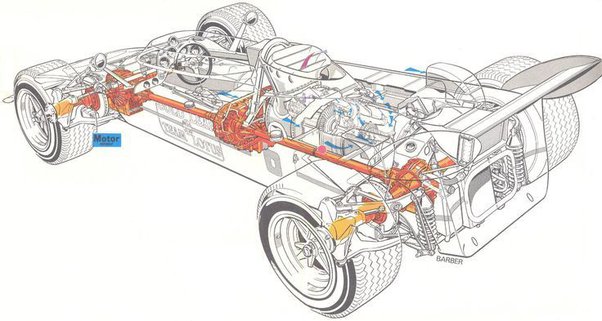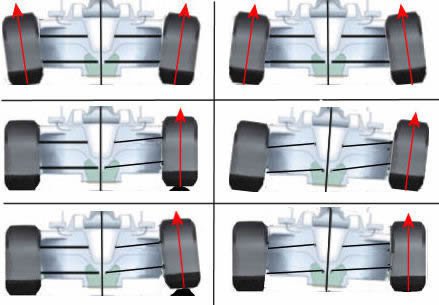Formula 1 cars are the pinnacle of motorsport, with incredible speed, power and agility. But are F1 Cars AWD or rear-wheel drive (RWD)?
Formula 1 cars are the ultimate racing machines, with incredible speed, power and agility. But how do they transfer their engine’s power to the wheels? Are they all-wheel drive (AWD) or rear-wheel drive (RWD)? And why does it matter? What are the advantages and disadvantages of each drive system for F1 cars?
In this article, we will answer these questions and explain why F1 cars are not AWD, but RWD. We will also look at the history of AWD in F1 and why it was banned by the governing body.
If you are interested in learning more about the drive systems of F1 cars and how they affect their performance and reliability, read on!
What is AWD and RWD?

AWD and RWD are two types of drive systems that transfer the engine’s power to the wheels. AWD means that all four wheels are powered by the engine, while RWD means that only the rear wheels are powered.
All wheel drive is usually considered to be better for traction, especially on slippery or uneven surfaces, as it distributes the power evenly among all four wheels.
RWD, on the other hand, is usually considered to be better for handling, as it allows the driver to steer the car with the throttle and control oversteer.
Why are F1 cars not AWD?
F1 cars are not AWD for several reasons. The main ones are:
AWD is Illegal in F1

The Fédération Internationale de l’Automobile (FIA), the governing body of F1, does not allow more than two-wheel drive in F1.
This rule was introduced in 1982 to prevent the development of costly and complex AWD systems that could give some teams an unfair advantage.
AWD Adds Weight and Complexity
AWD systems require additional components such as a differential, a transfer case, a driveshaft and an axle to connect the front and rear wheels.
These components add weight and complexity to the car, which can reduce its performance and reliability.
F1 cars are designed to be as light and simple as possible to achieve maximum speed and efficiency.
AWD Does Not Offer Significant Benefits for F1 Cars
AWD systems are mainly useful for improving traction on low-grip surfaces or in low-speed situations. However, F1 cars have very high levels of grip and downforce due to their aerodynamic design and tire technology.
They also rarely encounter low-speed situations, as they are constantly accelerating or braking at high speeds. Therefore, AWD does not offer much advantage for F1 cars in terms of speed or grip, but it does compromise their handling and cornering ability.
Why are F1 cars RWD?

F1 cars are RWD because it is the best system for getting maximum performance and reliability from their engines. Some of the reasons why RWD is better than AWD for F1 cars are listed below.
RWD Allows for Larger Rear Tires
F1 cars have different wheel sizes: the front tires are thinner than the rear tires, even though they have the same diameter. This is because the rear tires need to have more surface area to transfer the engine’s power to the road effectively.
This leaves the front tires being smaller to optimize steering.
AWD systems require all four wheels to be uniform, which would limit the size of the rear tires and reduce their grip.
RWD Improves Weight Distribution and Balance
F1 cars have most of their weight concentrated at the rear, where the engine and gearbox are located. This gives them a better weight distribution and balance than AWD cars.
They have more weight at the front due to the extra components.
A better weight distribution and balance means better handling and stability at high speeds.
RWD Simplifies the Design and Maintenance of the Car
RWD systems are simpler and lighter than AWD systems, as they only need to power two wheels instead of four.
This means less parts, less friction, less wear and tear, less fuel consumption and less maintenance.
RWD systems also allow for more flexibility in the design of the suspension, chassis and aerodynamics of the car.
The Pros and Cons of Adding AWD to an F1 Car
The pros and cons of AWD in F1 are listed below.
Pros
- Superb traction off the line & in the rain.
- Lesser tendency to oversteer & better drive out of corners.
Cons
- They’re heavy, around 150 kg’s.
- It would increase the weight by around 20% which is massive in F1.
- Increased technical complexity = Increased reliability issues.
- Increased tendency to understeer.
The History of AWD in F1
AWD was not always banned in F1. In fact, there were a few attempts to use AWD in F1 in the past, with varying degrees of success.
The first F1 car to use AWD was the Ferguson P99, which debuted in 1961. It was also the last front-engine car to win an F1 race. The Ferguson P99 used a mechanical system that split the power 50/50 between the front and rear wheels.
It had excellent traction and stability, but it was also heavy and slow.

The next F1 car to use AWD was the Matra MS84, which raced in 1969. It used a hydraulic system that varied the power distribution between 0/100 and 50/50 depending on the speed and steering angle of the car.
It was lighter and faster than the Ferguson P99, but it was also unreliable and difficult to control.
The last F1 car to use AWD was the Lotus 63, which also raced in 1969.

It used a gas turbine system that transferred the power from the engine to the wheels through a series of shafts and clutches.
The Lotus 63 was the most advanced and sophisticated AWD system at the time, but it was also the most problematic and unsuccessful. It suffered from overheating, vibration, lag and poor handling.
After these experiments, AWD was abandoned by F1 teams, as it proved to be more trouble than it was worth.
In 1982, the FIA officially banned AWD from F1, along with other technologies such as four-wheel steering, active suspension and traction control.
Conclusion
F1 cars are not AWD because it is not the best system for their performance and reliability. AWD systems are heavy, complex and unnecessary for F1 cars, as they have very high levels of grip and downforce from their aerodynamics and tires. RWD systems are lighter, simpler and more efficient for F1 cars, as they allow for larger rear tires, better weight distribution and balance, and more flexibility in design and maintenance.
AWD was tried in F1 in the past, but it was not very successful or popular. It was eventually banned by the FIA in 1982, along with other technologies that could give some teams an unfair advantage.
F1 cars are RWD because it is the best system for getting maximum performance and reliability from their engines.

